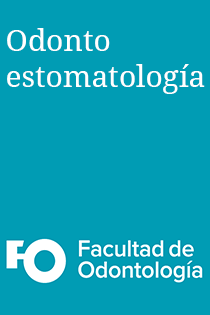Abstract
Objective: To analyze the bond strength to healthy and demineralized dentin, immediately and after 6 months, using a
2% chlorhexidine (CHX) pretreatment. Method: 40 healthy third molars with incomplete root development were abraded
exposing dentin. The pieces were subjected to pH cycling. They were randomly divided into 2 groups: with and without
CHX. In dentin, 4 resin buttons were created using universal adhesive in self-etching mode. The samples were stored in
distilled water at 37ºC until analysis. Micro shearing was carried out at 24 hours and at 6 months of aging. Results: Healthy dentin group, without immediate CHX presented higher bond strength (23.37±1.84). (Demineralized dentin group, without CHX, aged) presented the lowest bond strength (8.87±1.51). Conclusions: CHX prior to adhesive application doesn’t improve bond strength
values to healthy or demineralized dentin in short nor long term
References
Casagrande L, Seminario AT, Correa MB, Werle SB, Maltz M, Demarco FF, et al. Longevity and associated risk factors in adhesive restorations of young permanent teeth after complete and selective caries removal: a retrospective study. Clin Oral Investig. 2017 Apr;21(3):847-55. https://doi.org/10.1007/s00784-016-1832-1
Schwendicke F, Frencken JE, Bjørndal L, et al. Managing Carious Lesions: Consensus Recommendations on Carious Tissue Removal. Advances in Dental Research. 2016;28(2):58-67. doi:10.1177/0022034516639271
Uribe S. Partial caries removal in symptomless teeth reduces the risk of pulp exposure. Evidence-Based Dentistry. 2006 Dec 24;7(4):94–94.
Li T, Zhai X, Song F, Zhu H. Selective versus non-selective removal for dental caries: a systematic review and meta-analysis. Acta Odontologica Scandinavica. 2018 Feb 17;76(2):135–40.
Nagarkar S, Theis‐Mahon N, Perdigão J. Universal dental adhesives: Current status, laboratory testing, and clinical performance. Journal of Biomedical Materials Research Part B: Applied Biomaterials. 2019 Aug 14;107(6):2121–31.
Rodrigues JA, Casagrande L, Araújo FB, Lenzi TL, Mariath AAS. Restorative Materials in Pediatric Dentistry. In: Pediatric Restorative Dentistry. Cham: Springer International Publishing; 2019. p. 161–7.
Banerjee A. Minimal intervention dentistry: part 7. Minimally invasive operative caries management: rationale and techniques. British Dental Journal. 2013 Feb 8;214(3):107–11.
Rosa WL de O da, Piva E, Silva AF da. Bond strength of universal adhesives: A systematic review and meta-analysis. Journal of Dentistry. 2015 Jul 1;43(7):765–76.
Perdigão J, Swift EJ. Universal Adhesives. Journal of Esthetic and Restorative Dentistry. 2015 Nov 1;27(6):331–4.
Elkaffas AliA, Hamama HHH, Mahmoud SH. Do universal adhesives promote bonding to dentin? A systematic review and meta-analysis. Restorative Dentistry & Endodontics. 2018;43(3).
Shadman N, Farzin-Ebrahimi S, Mortazavi-Lahijani E, Jalali Z. Effect of chlorhexidine on the durability of a new universal adhesive system. Journal of Clinical and Experimental Dentistry. 2018;10(9):0–0.
Chen C, Niu L-N, Xie H, Zhang Z-Y, Zhou L-Q, Jiao K, et al. Bonding of universal adhesives to dentine – Old wine in new bottles? Journal of Dentistry. 2015 May 1;43(5):525–36.
Osorio R, Yamauti M, Osorio E, Ruiz-Requena ME, Pashley D, Tay F, et al. Effect of dentin etching and chlorhexidine application on metalloproteinase-mediated collagen degradation. European Journal of Oral Sciences. 2011 Feb;119(1):79–85.
Bravo C, Sampaio CS, Hirata R, Puppin-Rontani RM, Mayoral JR, Giner L. In-vitro Comparative Study of the use of 2 % Chlorhexidine on Microtensile Bond Strength of Different Dentin Adhesives: A 6 Months Evaluation. International Journal of Morphology. 2017 Sep;35(3):893–900.
Mazzoni A, Nascimento FD, Carrilho M, Tersariol I, Papa V, Tjäderhane L, et al. MMP Activity in the Hybrid Layer Detected with in situZymography. Journal of Dental Research. 2012 May 21;91(5):467–72.
Mobarak EH, El-Korashy DI, Pashley DH. Effect of chlorhexidine concentrations on micro-shear bond strength of self-etch adhesive to normal and caries-affected dentin. American journal of dentistry. 2010;23(4):217–22.
Marquezan M, Corrêa FNP, Sanabe ME, Rodrigues Filho LE, Hebling J, Guedes-Pinto AC, et al. Artificial methods of dentine caries induction: A hardness and morphological comparative study. Archives of Oral Biology. 2009 Dec;54(12):1111–7.
International Organization for Standarization. ISO 29022:2013 - Dentistry — Adhesion — Notchededge shear bond strength test. https://www.iso.org/standard/45285.html
Koyuturk A, Sengun A, Ozer F, Sener Y, Gokalp A. Shear Bond Strengths of Self-etching Adhesives to Caries-affected Dentin on the Gingival Wall. Dental Materials Journal. 2006;25(1):59–65.
Hosoya Y, Tay FR, Ono T, Miyazaki M. Hardness, elasticity and ultrastructure of primary tooth dentin bonded with a self-reinforcing one-step self-etch adhesive. Journal of Dentistry. 2010 Mar;38(3):214–21.
Shen J, Xie H, Wang Q, Wu X, Yang J, Chen C. Evaluation of the interaction of chlorhexidine and MDP and its effects on the durability of dentin bonding. Dental Materials. 2020 Dec 1;36(12):1624–34.
Bahari M, Oskoee SS, Esmaeel M, Chaharom E, Kahnamoui MA, Gholizadeh S, et al. Effect of accelerated aging and double application on the dentin bond strength of universal adhesive system. Dental Research Journal. 2021;1.
Lima JFM de, Wajngarten D, Islam F, Clifford J, Botta AC. Effect of adhesive mode and chlorhexidine on microtensile strength of universal bonding agent to sound and caries-affected dentins. European Journal of Dentistry. 2018 Oct 23;12(04):553–8.
Singh D, Srivastava SK, Chaudhuri TK, Upadhyay G. Multifaceted role of matrix metalloproteinases (MMPs). Frontiers in Molecular Biosciences. 2015 May 13;2(MAY):19.
Breschi L, Mazzoni A, Nato F, Carrilho M, Visintini E, Tjäderhane L, et al. Chlorhexidine stabilizes the adhesive interface: A 2-year in vitro study. Dental Materials. 2010 Apr;26(4):320–5.
Tessore R, Silveira C, Vázquez P, Mederos M, García A, Cuevas-Suarez CE, et al. Evaluación de la resistencia de unión a dentina humana de un sistema adhesivo universal con clorhexidina utilizado en modo de grabado total y autocondicionante. Odontoestomatología. 2020 Jun 6;22(35):20–9.
Sano H, Yoshikawa T, Pereira RNR, Kanemura N, Morigami M, Tagami J, et al. Long-term durability of dentin bonds made with a self-etching primer, in vivo. Journal of dental research. 1999;78(4):906–11.
Frassetto A, Breschi L, Turco G, Marchesi G, di Lenarda R, Tay FR, et al. Mechanisms of degradation of the hybrid layer in adhesive dentistry and therapeutic agents to improve bond durability--A literature review. Dental materials: official publication of the Academy of Dental Materials. 2016 Feb 1;32(2):e41–53.
Kiuru O, Sinervo J, Vähänikkilä H, Anttonen V, Tjäderhane L. MMP Inhibitors and Dentin Bonding: Systematic Review and Meta-Analysis. Isola G, editor. International Journal of Dentistry. 2021 May 27;2021:1–14.

This work is licensed under a Creative Commons Attribution-NonCommercial 4.0 International License.


